What looks like a rail, crane, ibis and heron, and screams like a banshee? Is it a rail-crane-ibis-heron banshee bird?
No, it’s a Limpkin (Aramus guarauna), a peculiar wading bird.
The large and gangly Limpkin is 25-28 inches (63-71 cm) in length with a wingspan of 40-42 inches (101-107 cm). The relatively common Limpkin has long legs, a long neck and a long, downcurved bill. Its yellow bill has a gap before its black tip, which allows it to function as a tweezers. Limpkins use it to shuck large snails.
It’s not quite a can opener, but it’s an efficient snail opener. The bird’s eyes are reddish and its webless feet are a dark grayish-green. It has a brown plumage speckled with white spots and streaks. Underwing coverts show white mottling, which is visible in flight. The wings are long and wide, and the tail is short.
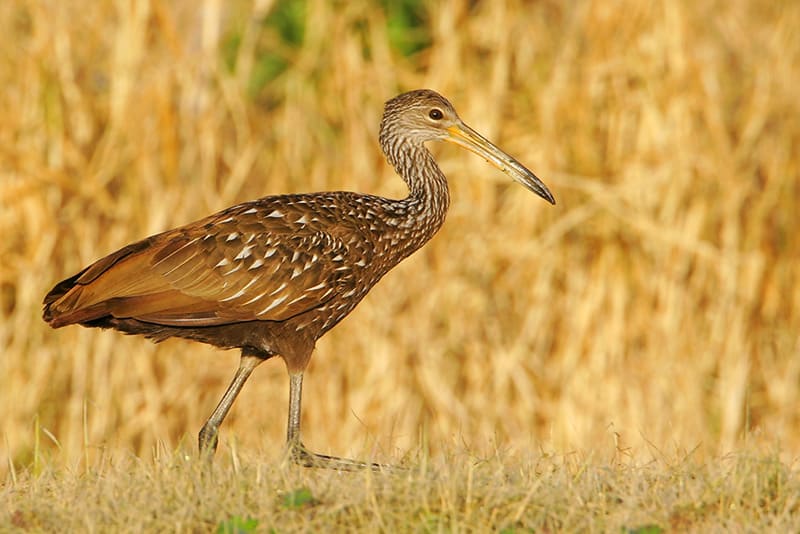
Limpkins inhabit freshwater marshes, lakeshores and wooded swamps. They breed in Florida, southern Georgia and have moved into Louisiana. They have likely become residents of Texas and further expansion of breeding territory is probable. Limpkins are also found in the Caribbean, Central America and South America.
Identification
The sexes are similar, but the male is slightly larger than the female. A juvenile is similar in appearance to an adult, but it has narrower white spots, giving it a streaked appearance.
The male is the one that produces the loud wailing and screaming cries. When heard at night, these sounds cause people sharing a tent to play the “What was that?” game. The females are relatively silent in comparison.
Food
Limpkins forage by walking through shallow water, visually searching for food. They also use their bill to probe and poke about in the mud and vegetation as an ibis does. Limpkins readily forage at night, even when it’s raining.
The Limpkin is a devotee of escargot. Its diet consists mostly of golf ball-sized apple snails, but as an opportunistic omnivore, a Limpkin doesn’t live by snails alone and eats freshwater mussels, insects, frogs, crustaceans, seeds, lizards and worms.
An unexpected boost to the Limpkin population has been provided by the introduction of invasive non-native apple snails that have escaped or were released from aquariums.
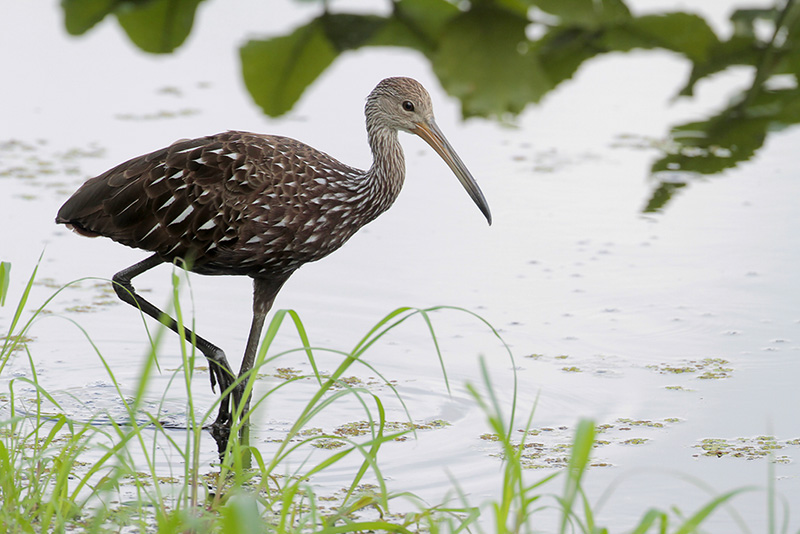
Limpkin
Nesting and Eggs
The male Limpkin selects the nest site, displaying his preference by arranging the vegetation and calling out sweet nothings to females. Limpkins could place a nest almost anywhere, but it’s usually partially hidden near water. They nest in tall marsh grasses, on top of floating vegetation, up to 40 feet high in trees or tree cavities, and in previously owned Osprey nests.
There are typically 4-7 eggs that are 2.2-2.5 inches long and vary in color from olive to buffy, blotched with brown and gray. Both males and females incubate the eggs, with the incubation period being 26-28 days. Limpkins have 1-3 broods a year.
Nest building is initially undertaken by the male in his territory before the pair-bond formation. Unpaired females visit several territories before settling on the male of their dreams. Courtship feeding is part of the bonding process.
The male catches a snail and feeds it to the female. The nests are made of vegetation found near the nest site. Nests average about 20 inches in diameter and are 3 inches deep.
Limpkin young are precocial, meaning they are developmentally advanced when they hatch–brown balls of fluff covered in down, and able to walk, run and swim by the time they leave the nest within a day after hatching. Juveniles disperse when 13 to 17 weeks old.
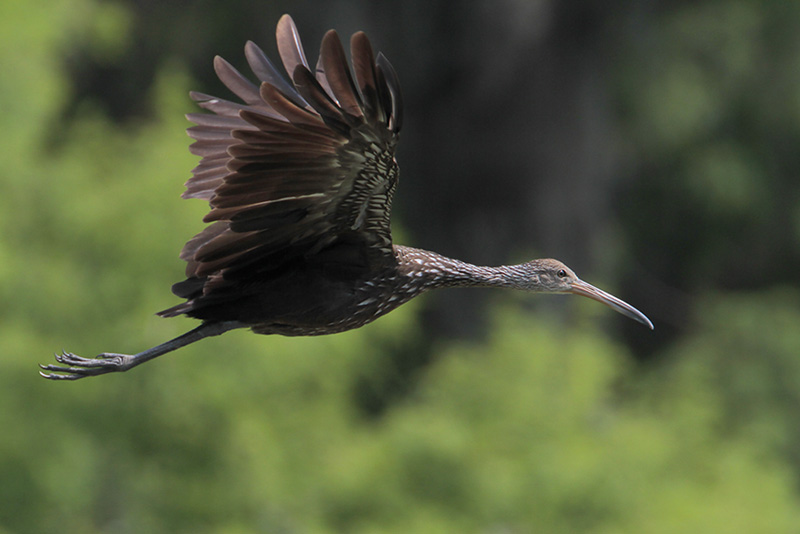
Current Situation
Birds have wings even if snails don’t. Birds don’t read field guides or move at a snail’s pace. Limpkins readily consume both native and invasive apple snails and the abundant food resource of invasive snails is likely enabling the increased range of Limpkins, as both the snails and the Limpkins are being seen where they haven’t been seen before.
Limpkins were nearly extirpated from Florida due to overhunting.
Conservation efforts and laws stopped this, yet other dangers remain—habitat destruction, wetland drainage, non-native vegetation, flood control, development and pollution. Limpkins are vulnerable because of habitat loss and degradation, but remain protected by law and conservation efforts are ongoing to ensure their survival.
Limpkin Facts
- The Limpkin got its name from the awkwardness of its gait when it is disturbed, which people interpreted as a limp.
- The collective noun for limpkins is said to be a hobbling, and it might be.
- Alligators prey upon adults and the eggs are taken by many hungry critters, including snakes, crows, muskrats and raccoons.
- Limpkins don’t have webbed feet, but they are good swimmers.
- Limpkins often walk on a mat of floating vegetation while hunting snails.
Similar Species
There is no other bird like a Limpkin. It’s like every other bird in that it’s unique, but here are some bird species that could be confused with a Limpkin and some simple tips to differentiate them from a Limpkin.
- A juvenile White Ibis has an orange-hued bill that is both more pointed and more curved than a Limpkin’s.
- A Great Blue Heron is a blue-gray bird that is much larger than a Limpkin.
- A Sandhill Crane is much larger and lacks a yellow bill.
- A Glossy Ibis is darker and its bill is more curved than that of a Limpkin.
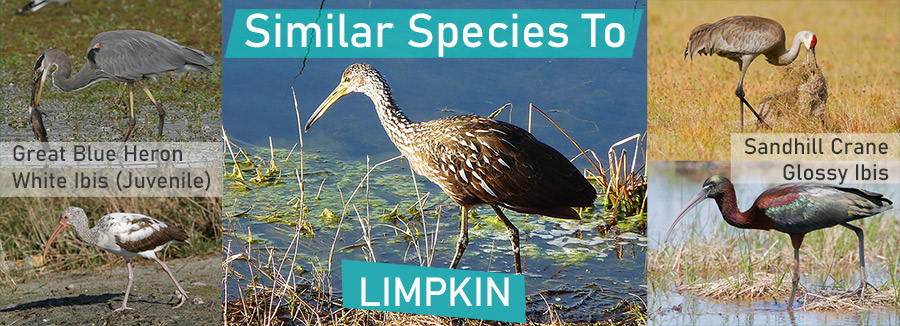
FAQ
Why do Limpkins scream?
Limpkins scram to be heard. Territorial males issue a loud mournful call at night, earning them the nicknames of the “wailing bird” or “crying bird.” It sounds like a prehistoric pterosaur had gotten its tail caught under a rocking chair.
It might say “kerr-rr-rr-owh” or it might not be saying “kerr-rr-rr-owh.” They mark their territory with loudness. The screeching cry of the mythical hippogriff, a creature with the front legs, wings and head of a giant eagle and the body, hind legs and tail of a horse that appears in Harry Potter movies, is the cry of the Limpkin obtained from the Macaulay Library of recordings. The Limpkin’s wail has been used repeatedly as a background sound in old Tarzan movies and on jungle soundtracks.
Can a limpkin fly?
Yes. They typically fly short distances to reach food or water sources and to sort out territorial disputes. A Limpkin’s flight resembles that of a crane as it flies with its head and neck extended while its legs trail behind.

While often seen in water, Limpkins can fly!
Do Limpkins migrate?
They aren’t migratory, but dispersing individuals are occasionally found far from their normal range (even in Minnesota!), much to the delight of birders. The proliferation of non-native, invasive apple snails has made them travelers.
Are Limpkins endangered?
Limpkins, while not federally listed as Endangered, are protected by the Florida Endangered and Threatened Species Rule. Partners in Flight gives the species a 10 out of 20 on the Continental Concern Score, meaning it’s a species of low conservation concern.

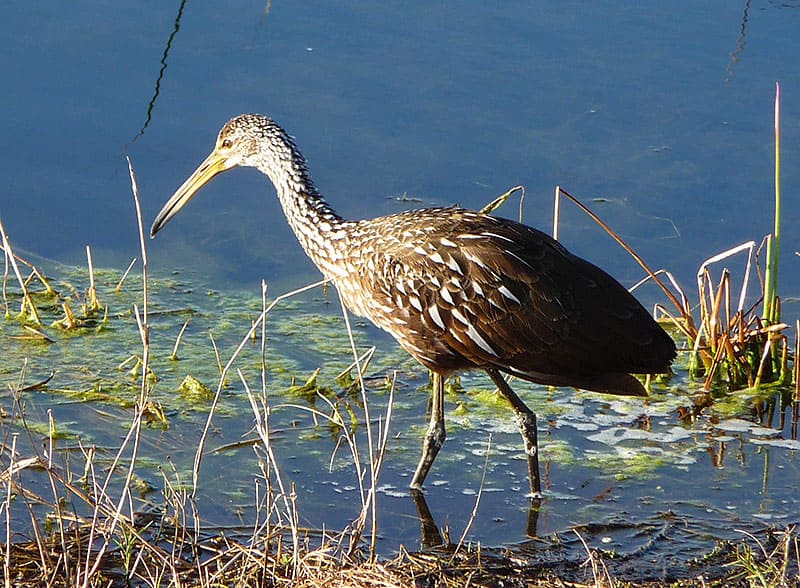

Jill Goff
Friday 19th of April 2024
We have a Limpkin family and notice that dad has one chick with him constantly when feeding, and the other two are always with the mom.
Do the chicks follow their gender role?
Patrick O'Donnell
Monday 22nd of April 2024
@Jill- That's an interesting observation. Since male and female Limpkin chicks look alike, it's impossible to say which one is following which parent.
Robert H. Holt
Tuesday 6th of June 2023
Hey Sam, this is a great article on the Limpkins. I am a photographer in Arkansas and have been filming Limpkins for the past 5 years here in Arkansas. We are beginning to see more and more each year. I am not sure if it is due to lose of food in their normal areas or what. I do know they are voracious eaters and consume mussels and small snails here with an occasional crayfish. I am watching one pair in Central Arkansas in hopes they will make their home here, however I am concerned if we get more and more what that will do to our mussel population. Again, Thank you for this article, it is hard to find much information on these beautiful birds. Sincerely, Robert H. Holt
Patrick O'Donnell
Friday 9th of June 2023
@Robert- Glad you enjoy the article! Limpkins are such unique birds. You are witnessing a sudden range expansion of this interesting bird! During the past few years, this species has been seen in many areas north of its usual range. It is hard to say what sort of impact they might have on mussel populations in your area. However, at the moment, these birds moving north have not become established.